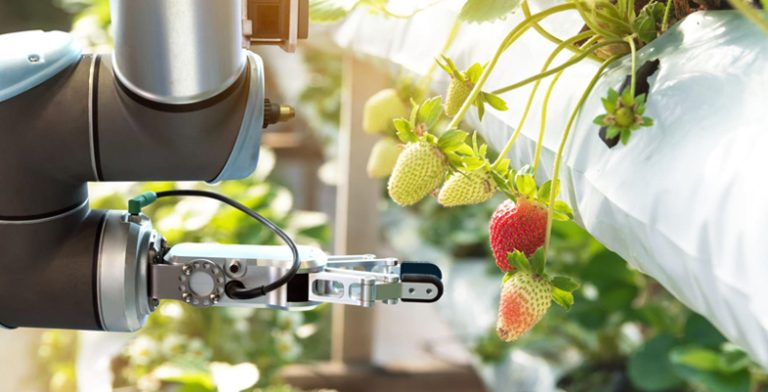The food industry plays a critical role in providing sustenance to the global population. However, the traditional food supply chain has faced various challenges, such as inefficiencies, food waste, and limited visibility. In recent years, technology has been a game-changer in disrupting the traditional food supply chain. This article explores the impact of technology on the food industry and how it is revolutionizing the way food is produced, processed, distributed, and consumed.
Precision Agriculture and Smart Farming
Precision agriculture leverages technology, such as GPS, sensors, and drones, to optimize farming practices. Smart farming enables farmers to monitor crop health, soil moisture, and nutrient levels in real time. By using data-driven insights, farmers can make informed decisions to maximize crop yields, reduce resource usage, and minimize environmental impact.
Vertical Farming and Controlled Environment Agriculture
Vertical farming and controlled environment agriculture (CEA) are innovative approaches that use stacked layers and controlled conditions to grow crops indoors. This technology eliminates the need for vast agricultural land and enables year-round production, regardless of external weather conditions. Vertical farming conserves water, reduces transportation costs, and brings food production closer to urban centers, enhancing food security.
Blockchain in Food Traceability
Blockchain technology provides an immutable and transparent ledger that can be utilized for food traceability. By recording every stage of the supply chain on the blockchain, from farm to table, consumers can easily trace the origin and journey of the food they consume. This enhances food safety, reduces fraud, and builds trust between consumers and producers.
Internet of Things (IoT) in Cold Chain Management
The Internet of Things (IoT) has transformed cold chain management in the food industry. IoT devices and sensors monitor temperature, humidity, and other critical factors during food transportation and storage. Real-time data enables proactive measures to prevent spoilage and reduce food waste during transit.
Robotics and Automation in Food Processing
Robotics and automation have revolutionized food processing, streamlining production lines and ensuring consistency and efficiency. Robots can perform repetitive tasks, such as sorting, cutting, and packaging, with precision and speed. Automation reduces labor costs and the risk of contamination, improving food safety.
Food Delivery Platforms and Meal Kits
Technology has disrupted the way consumers access food through food delivery platforms and meal kit services. Apps and websites offer convenient options for ordering food from restaurants and grocery stores, which can be delivered directly to consumers’ doorsteps. Meal kits provide pre-portioned ingredients and recipes, allowing consumers to cook restaurant-quality meals at home.
AI and Personalized Nutrition
Artificial intelligence (AI) is transforming personalized nutrition. AI-powered apps and platforms analyze individuals’ dietary preferences, health conditions, and goals to offer personalized meal plans and nutrition recommendations. This technology empowers consumers to make informed choices that align with their unique nutritional needs.
Food Waste Reduction Technologies
Food waste is a significant challenge in the food industry. Technology is tackling this issue through various means, such as data analytics to optimize inventory management, apps that connect surplus food with food banks, and biotechnology that converts food waste into valuable resources like biogas and animal feed.
3D Printing in Food
3D printing has entered the food industry, allowing chefs and food manufacturers to create intricate and personalized food designs. This technology has the potential to revolutionize food presentation and enable custom food production for specific dietary requirements or medical needs.
Food Safety and Quality Control
Technology is enhancing food safety and quality control measures. Sensors, AI, and data analytics can detect contaminants, spoilage, and inconsistencies in food products. Real-time monitoring and rapid detection help prevent foodborne illnesses and maintain high-quality standards throughout the supply chain.
Predictive Analytics and Demand Forecasting
Predictive analytics uses historical data and machine learning algorithms to forecast future demand patterns accurately. Consumer companies and food producers can utilize predictive analytics to optimize inventory levels, production schedules, and distribution strategies. By anticipating fluctuations in demand, businesses can prevent shortages and excess inventory, leading to cost savings and improved customer satisfaction.
Digital Marketplaces and Direct-to-Consumer Sales
Digital marketplaces have disrupted the traditional food distribution model by connecting consumers directly with producers and farmers. These platforms allow producers to reach a broader audience without the need for intermediaries, reducing distribution costs and offering consumers greater product variety and transparency. Direct-to-consumer sales enable producers to build a loyal customer base and gather valuable feedback, contributing to product improvement and innovation.
Cloud Computing and Data Management
Cloud computing has revolutionized data management in the food industry. Storing and processing vast amounts of data on cloud-based platforms enables companies to access information from anywhere in real time. Cloud solutions facilitate collaboration between stakeholders, enhance supply chain visibility, and support data-driven decision-making.
Smart Packaging and Shelf Life Extension
Smart packaging solutions integrate technology, such as sensors and indicators, to monitor the condition of food products during storage and transportation. These innovations help extend shelf life, reduce food spoilage, and ensure that consumers receive fresher and safer products. Smart packaging can also provide consumers with information about product quality and freshness.
Robotics in Food Service and Restaurants
Robotics is transforming the food service industry, particularly in restaurants and quick-service establishments. Automated food preparation, self-service kiosks, and robotic waiters streamline operations and reduce the need for human labor. This technology enhances efficiency, improves order accuracy, and elevates the overall dining experience for customers.
Big Data and Consumer Insights
Big data analytics enables food companies to gain valuable insights into consumer preferences, behaviors, and trends. Analyzing data from social media, online reviews, and purchase history helps companies tailor marketing strategies, launch targeted campaigns, and develop products that align with consumer demands.
Sustainable Sourcing and Transparent Supply Chains
Consumers are increasingly conscious of sustainability and ethical practices. Technology facilitates transparent supply chains, allowing companies to trace the origin of raw materials and ensure sustainable sourcing. Implementing blockchain technology and IoT sensors can provide real-time visibility into supply chains, verify claims of sustainability, and foster consumer trust.
Mobile Apps for Food Safety and Allergen Management
Mobile applications are enhancing food safety and allergen management for both consumers and food businesses. Apps can provide allergy information, ingredient lists, and nutritional details, enabling consumers to make informed choices. For food businesses, mobile apps help track and manage allergen information, reducing the risk of contamination and liability.
Automated Quality Control and Inspection
Automated quality control systems use computer vision and AI to inspect food products for defects, contaminants, and conformity to quality standards. These systems ensure consistency and eliminate human errors, guaranteeing that only products meeting quality criteria reach the market.
AI-Driven Food Innovation and New Product Development
Artificial Intelligence is transforming food innovation and new product development. AI algorithms can analyze vast amounts of data to identify emerging food trends, consumer preferences, and potential product concepts. By leveraging AI insights, companies can create innovative food products that resonate with evolving consumer demands.
Conclusion
Technology continues to disrupt the traditional food supply chain, driving innovations and improvements across the entire industry. Predictive analytics, digital marketplaces, and smart packaging optimize distribution and reduce food waste. Cloud computing and data management enhance supply chain visibility and collaboration. Robotics and automation streamline food service operations, while big data and consumer insights inform targeted marketing and product development. Sustainable sourcing and transparent supply chains build consumer trust, and mobile apps enhance food safety and allergen management.
Automated quality control and inspection ensure product consistency and safety. AI-driven food innovation fosters creative new products that align with changing consumer preferences. Embracing these technological advancements enables the food industry to stay competitive, sustainable, and consumer-focused in an ever-evolving world. By continually innovating and adapting, the food industry can meet the demands of a growing global population while addressing challenges such as food security and environmental sustainability.






